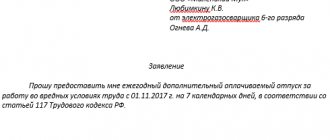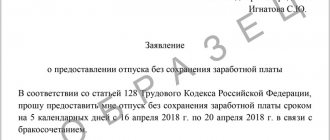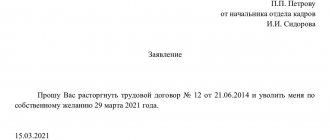Home/Time off/On account of vacation
In a number of circumstances, an employee may need time off for vacation - that is, the opportunity to legally spend a certain amount of working time away from work.
IMPORTANT
The reasons can be very different - but the main thing to remember is that the fact of receiving time off for vacation must be properly documented so that in the future the employee does not face charges of violating labor discipline and does not become subject to appropriate sanctions related to this violation.
Let us consider in more detail the legal regulation of this issue and the procedure for obtaining and processing.
What is compensatory time off?
Time off for vacation is a specific formula for interaction between an employee and an employer, when the former is given the opportunity to legally formalize a short-term absence from the workplace (1-2 days) so that this fact is not counted as absenteeism.
Attention
According to labor law, an employee has the right to annual paid leave, and Article 125 of the Labor Code states that it can be provided to the employee in parts throughout the year, provided that one of its parts lasts at least 14 calendar days.
If this condition is met, the other agreed parts of paid leave are not limited in duration, that is, they can last 1 or 2 days. Of course, we are talking about the general period of the paid period, stipulated by the working conditions.
Therefore, compensatory time off is, in essence, an unused part of the vacation period provided to the employee with the written consent of the employer. If an employee takes such a one-day leave, the employer is obliged to pay it in full, in accordance with labor legislation.
How long can leave be granted?
The period of unpaid leave can be any, but within the limits of the number of days of the employee’s next vacation. As a general rule, the duration of annual leave is 28 calendar days. But there are categories of workers who have the right to extended leave.
Such employees include:
- those employees whose working conditions were found to be harmful or dangerous. After the certification, the employer receives a certificate stating that some workplaces belong to the 2nd, 3rd and 4th hazard groups. Employees who work in such conditions are entitled to at least 7 additional days of paid leave per year;
- those employees who have a special nature of work. For example, general practitioners are entitled to 3 additional paid days off. The exact list of professions, as well as the minimum duration of additional leave, are prescribed in the relevant Resolutions of the Government of the Russian Federation;
- employees who have irregular working hours can legally rest 3 days more than other employees;
- citizens working in the Far North or in areas that have a similar status. They have the right to additional leave lasting 8 – 24 calendar days;
- other employees, at the discretion of the employer.
An employee has the right to leave after he has worked for six months. He has the right to use all 28 days immediately, but in advance. The employer has no right to refuse him. If the parties agree among themselves, then leave can be given before the expiration of the six-month period. In the same way, the employee may be allocated several days to rest towards future vacation.
If an employee has several days of vacation that he did not use in the previous period, then he also has the right to take them at any time convenient for him. But for this you also need to write a statement. Only the wording needs to be changed a little. In the “body” of the application you need to state the request “I ask you to provide the unused part of the annual leave for ____ year.” It is necessary to indicate the year for which the employee has several days left.
Payment for additional days for rest, which are taken towards future vacation, is made in the same way as payment for the vacation itself. That is, the average daily earnings are calculated and then multiplied by the number of days the employee takes.
But since the vacation is divided into parts, the average employee’s earnings in one month may differ from the same indicator in another month. Therefore, each time a part of the vacation is granted, a recalculation must be made.
Thus, a worker must take one day towards future vacation 14 times a year. That is, one part of the vacation cannot be less than 14 days, and he can split the rest as he pleases. If he decides to take 1 day at a time, he can do this 14 times during the year.
Labor Code of the Russian Federation
The Labor Code of the Russian Federation does not provide for the existence in the legal field of such a concept as “time off”. Instead, it is common to talk about vacation (regardless of its duration). Formally, the law does not distinguish between a long period of rest for an employee and leave received for 1 or 2 days due to a specific need.
Article 114 of the Labor Code of the Russian Federation guarantees each employee the opportunity to receive annual paid leave while maintaining their job and average salary throughout the entire period under review.
For your information
In this case, vacation can be taken not at once, but in several parts throughout the year, as mentioned above. The only condition for this is the existence of a mutual agreement between the parties.
It is also important to take into account some of the nuances of the regulatory framework governing the area of labor relations under consideration.
Although the Labor Code of the Russian Federation does not contain the concept of time off on account of vacation, many norms of labor legislation, one way or another, regulate this issue.
In particular:
- Articles 114-116 of the Labor Code of the Russian Federation reflect the conditions and procedure for receiving paid annual leave, as well as the possibility of distributing it throughout the year;
- Articles 117-120 of the Labor Code of the Russian Federation reveal certain aspects of the procedure for applying for additional leave and stipulate its possible fragmentation;
- Articles 121-126 of the Labor Code of the Russian Federation discuss the registration, payment, distribution of the vacation period, as well as its possible compensation through cash payments;
- Article 128 of the Labor Code of the Russian Federation concerns the procedure for taking leave without financial compensation and regulates its possible duration.
How to apply for time off as a vacation?
Although labor legislation does not provide for such a category as “time off on account of vacation,” the actual existence of this phenomenon obliges it to be regulated in the prescribed manner.
In order to correctly arrange a short-term vacation period, an employee must complete the following procedure:
- prepare and submit a corresponding application addressed to the manager (in this document it is recommended to indicate the reasons for extraordinary release from official duties, although this point is not mandatory);
- the application is accompanied by documentary evidence of the reason that prompted the employee to apply - for example, this could be a copy of the application to the registry office, a copy of the death certificate of a family member or the birth of a child;
- then the employer reviews the application and, if approved, issues the appropriate visa;
- the approved application goes to the personnel department, where, on its basis, an order is prepared confirming that the employee has received an exemption from official duties, with or without wages.
If the employer does not confirm the received application, the requested dismissal is considered invalid, and the absence from work may be counted as absenteeism to the employee.
In turn, this violation of labor discipline may cause dismissal. Therefore, the procedure for documenting time off on account of vacation should be treated extremely responsibly and carefully. If everything is done correctly, absence from the workplace is legal, and the employee can calmly go about his business without worrying about a possible labor conflict and its consequences.
How to apply
Time off is granted only on request. The application is submitted for approval to the head of the structural unit. He signs his visa, thereby agreeing. Then the application is transferred to management, and only then to the human resources department.
The personnel service issues an order assigning this employee an additional day of rest.
It is worth paying attention to some nuances when providing paid time off:
- Those days of additional rest that are provided based on actual time worked are paid in full. This rule also applies to donors;
- time off must be agreed upon with management. If this is not done, then absence from work may be regarded as absenteeism;
- an additional day is taken for previously worked time;
- For previously worked time, only one type of compensation is provided - either payment or a day of rest.
If the time off is not paid, then the following nuances are taken into account:
- You can take such time off only at your own expense;
- this must be indicated in the application;
- this day will not be paid and will not be taken into account when calculating average earnings.
That is, the lack of overtime does not allow the employee to receive an additional day of vacation. Therefore, he is left with two options:
- take an unpaid day off at your own expense;
- take a day off as part of your regular annual vacation.
The law states that it is not the employer’s responsibility to allocate leave to its employees in parts. This is his right, but not his obligation. Vacation can be split only with the approval of your superiors.
The fact is that all vacations are provided according to a pre-approved schedule. The schedule is drawn up at the end of the current year with the calculation of vacations for the next year. Not only the order of priority is taken into account, but also the interchangeability of workers. Therefore, making any changes to the schedule will certainly affect other workers.
Therefore, you need to obtain permission from your superiors to use vacation in parts. This is precisely the problem when asking for time off on account of a future vacation.
If the employer does not welcome the splitting of vacations, then he is also not willing to provide time off for vacation. In addition, the Labor Code of the Russian Federation specifies cases when management is obliged to give its employee several unpaid days:
- to all employees in the event of a wedding, birth of a child or death of a close relative. The employee has the right to demand at least 5 additional unpaid days off. But the employee must provide supporting documents;
- Working pensioners can count on 14 additional unpaid days per year if they are granted an old-age pension;
- family members of military personnel who were injured in service or died in the performance of their duties can count on 14 additional unpaid days per year;
- Working disabled people can count on 60 additional unpaid days per year;
- parents who have children under three years of age. Time off is provided by agreement with management.
Order for time off on account of vacation
As mentioned above, the result of a correctly completed registration procedure is an order from the manager to release the employee from work duties for a certain period (the document indicates the exact number of days).
Time off can be provided as part of paid leave with full pay, or without financial support.
In this case, the order is a mandatory part of the registration procedure, since it confirms the legality of the employee’s absence from the workplace.
An order for time off on account of vacation is drawn up on the letterhead of an enterprise or organization, has a number of legally specified details, and must be certified by the signature of the manager and the seal of a legal entity.
Cases when a leave order is not required
It is worth mentioning additionally some points in the procedure for granting short-term release from work, when an order for time off on account of vacation is not required.
In particular, time off may be provided as compensation for time worked outside of normal hours, including on weekends. In this case, the employee fills out an application, and the manager simply confirms the visa.
No order is required in such circumstances.
In addition, releasing an employee from official duties may be a form of reward for certain achievements. An order is also not required here.
In all other cases, issuing an order for time off on account of vacation is a mechanism to protect the financial interests of the employee.
If the short-term vacation period is paid, the order to provide it to the employee must be transmitted to the accounting department, and there they accrue vacation pay and pay compensation 3 days before the employee is actually released from duties.
Statement
In official documentation, the concept of “time off” is replaced by the term “vacation”, or “day off”.
The basis for providing it to the employee is a statement written in his own hand, which is drawn up according to a standard template.
An application for time off for vacation has a simple structure and is not difficult to draw up.
As in any official document of this type, the position and full name are indicated in the upper right corner. the head of the company or organization, and below - the position and full name. compiler. That is, it is indicated to whom the application is addressed and from whom it is made.
Below these details, in the middle of the sheet, write the word “Application”.
And finally, the text of the application itself - it must be clear, concise, and contain the main conditions of the request.
It is imperative to indicate information about the period for which the applicant wishes to receive temporary leave from work (they write in the application - leave for such and such a period, or an additional day off on account of the next annual paid leave).
The statement also indicates the reason for the request:
- marriage;
- birth of a child;
- death of one of the relatives;
- other.
If the leave guaranteed by the terms of employment has already been used, but there is a need for dismissal from work, the application says “I ask for a day off without pay.”
A date and signature are placed at the bottom of the application for time off due to vacation.
There is no uniform standard for the formatting of this document, but it is worth following the general recommendations of business ethics. It is desirable that the application be drawn up without any marks and have a presentable appearance, because it is an official document.
A standard application form can be provided by the Human Resources Department. In another case, it can be written by hand, or typed on a computer and then printed on A4 sheet. In this case, the signature must be placed manually.
Who is entitled to time off and when?
Time off may be granted on the following grounds:
- the employee worked overtime;
- there is a need for him to perform his work duties on weekends or holidays;
- total processing during the rotation method;
- active participation in the donor movement;
- free blood donation;
- towards future annual leave;
- at your own expense.
Time off is granted on request.
There are several options for using your earned rest day:
- receive additional payment to your regular salary;
- book one more (or several) days for your annual leave;
- arrange an additional day off on any day. Which will be convenient for the employee.
Time off for vacation
The total period of possible time off on account of vacation, received on account of vacation, should not exceed the agreed total time of the vacation period as a whole (taking into account the two weeks that the employee is required to “take time off” in full).
The duration of one leave usually lasts from 1 to 3 days. But there are a number of exceptions in which the period may be longer:
| Condition of receipt | Duration |
| In the event of the death of a family member, marriage, or the birth of a child. | Up to 5 days. |
| For participants of V.O.V. | Up to 35 days (for pensioners – 14 days). Disabled persons are provided with time off up to 60 days per year. |
| For spouses and parents of fallen military personnel. | Up to 14 days. |
| For students and students of secondary specialized educational institutions. | Up to 15 days – during entrance exams, up to 30 days – for final exams, up to 4 months – to prepare and submit a diploma project. |
At the same time, all employees should keep in mind that if the total duration of unpaid time off exceeds 14 days per year, the excess will be deducted from their seniority. This situation, among other things, may further affect the calculation of pension payments.
Payment
Depending on the nature of the registration, there are three schemes for paying time off for vacation as an element of the labor relationship:
- payment within the framework of guaranteed monetary compensation for annual basic or additional leave;
- payment for the time an employee is absent from the workplace due to vital factors of the enterprise or organization;
- lack of monetary compensation due to receiving time off outside the agreed duration of paid leave.
If time off is taken as vacation time, it is technically considered part of paid vacation and is paid accordingly. Typically these payments correspond to the average daily wage.
It is important that the order to release a person from official duties is sent to the accounting department in a timely manner.
There, appropriate accruals are made, and the amount of monetary payment is provided to the employee no later than 3 days before the person is actually released from performing work functions.
If an employee’s failure to fulfill official duties is due to downtime at work, and not personal desire, the employer is obliged to pay for this period of forced inactivity at the rate of 2/3 of average earnings for each day of downtime.
If time off is received not as part of paid leave, but outside of it, financial support is not provided. At the same time, the absence of an employee on site is not considered absenteeism and does not entail any additional penalties.
How many days can I take?

The number of days of the period that an employee can request without pay is not limited by law.
Even within one year or month, there is no specific number of days that an employee could or could not receive as additional days off without saving wages through vacation or other means. If an employee wishes to take any period in lieu of annual rest, the number of such days may be limited to the length of unused leave.
However, the employer has the right to agree on a larger number of days if he is sure that the employee will work for a long time and will accumulate the required period. However, this option is risky and the company’s management is unlikely to accept it.
How is time off for vacation indicated on the timesheet?
A report card on attendance at the workplace and performance of official duties is a document that the responsible person submits monthly to the accounting department, on the basis of which salaries are calculated. If an employee is absent from the workplace for some reason, this must be recorded in the time sheet. Typically, in the design of this document, standard designations, symbols and abbreviations are used, which make it possible to calculate the employee’s production efficiency.
Since formally, in the case of time off, the category “paid leave” or “day off” is used, the employee’s absence from the workplace is usually noted in the workload report card with the abbreviations “O” (vacation) or “B” (day off).
If time off is received as part of paid leave, the period will be paid in the same amount as time spent performing official duties.
It is very important to keep in mind that the actual duration of the leave must correspond to the period specified in the order, otherwise the employee will be counted as absenteeism.








